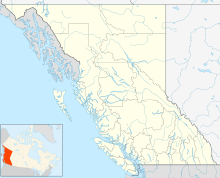Radium Hot Springs | |
|---|---|
| Village of Radium Hot Springs[1] | |
 | |
Location of Radium Hot Springs in British Columbia | |
| Coordinates: 50°37′03″N 116°04′19″W / 50.6175°N 116.072°W | |
| Country | Canada |
| Province | British Columbia |
| Region | Columbia Valley/East Kootenay (Canadian Rockies) |
| Regional district | East Kootenay |
| Incorporated | 1991 |
| Government | |
| • Governing body | Radium Town Council |
| • Mayor | Michael Gray |
| Area | |
| • Land | 6.34 km2 (2.45 sq mi) |
| Elevation | 808 m (2,651 ft) |
| Population (2021)[2] | |
• Total | 1,339 |
| • Density | 211.3/km2 (547/sq mi) |
| Time zone | UTC−7 (MST) |
| • Summer (DST) | UTC−6 (MDT) |
| Postal code | V0A 1M0 |
| Area code | 250 / 778 / 236 |
| Website | radiumhotsprings |
Radium Hot Springs, informally and commonly called Radium is a village of 1,339 residents in the East Kootenay region of British Columbia. The village is named for the hot springs in the nearby Kootenay National Park. From Banff, Alberta, it is accessible via Highway 93.
The hot springs were named after the radioactive element when an analysis of the water showed that it contained small traces of radon which is a decay product of radium.[3] The radiation dosage from bathing in the pools is inconsequential: approximately 0.13 millirems (1.3 μSv) from the water for a half-hour bathing, around ten times average background levels. The air concentration of radon is about 850 becquerels per cubic metre (23 pCi/L) which is higher than the level (200 Bq/m3 or 5.4 pCi/L) at which mitigation within two years is encouraged at residences;[4] but is also inconsequential (about 0.7 mrem or 7.0 μSv for a half-hour bathing) from a dose impact perspective.[5]
- ^ "British Columbia Regional Districts, Municipalities, Corporate Name, Date of Incorporation and Postal Address" (XLS). British Columbia Ministry of Communities, Sport and Cultural Development. Retrieved November 2, 2014.
- ^ a b "Population and dwelling counts, for Canada, provinces and territories, and census subdivisions (municipalities), 2021 censuses – 100% data (British Columbia)". Statistics Canada. February 9, 2022. Retrieved February 18, 2022.
- ^ "Radium Hot Springs - Radium, BC". Retrieved 2009-08-27.
- ^ "Guide for Radon Measurements in Residential Dwellings" (PDF). Retrieved 2022-09-27.
- ^ "How do I interpret these radon concentration numbers from early hot springs measurements?". Retrieved 2009-08-27.
